Your Deer Are Here
Where and How to Hunt for Bucks as Seasons Get Cranking in September
By Bill Adelman
With several deer hunting seasons in full swing in California, options are many for hunters, assuming one will fit our personal needs.
Not many of us own or have access to a 20,000-acre ranch in the B Zone (most of the North Coast from the border to the Bay Area) that is crawling with deer, hogs, coyotes, cats, game birds and snakes. Option two is to join an established annual dues hunting club that offers access to hunts behind locked gates (reservations for all hunts required). You generally have good property to hunt, though you’re entirely on your own.
 Number three might be a guided hunt, of which there are a few options. A fully outfitted hunt offers full-time guides, generally two to one, unless you kick in a few extra bucks to hunt one on one with
Number three might be a guided hunt, of which there are a few options. A fully outfitted hunt offers full-time guides, generally two to one, unless you kick in a few extra bucks to hunt one on one with 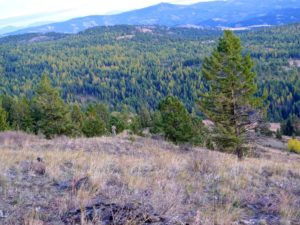 a guide. They provide lodging, food, transportation, spot and stalk, blinds, in-field care, skinning, and in some cases even a walk-in cold box to hang your game. These are really the cat’s meow.
a guide. They provide lodging, food, transportation, spot and stalk, blinds, in-field care, skinning, and in some cases even a walk-in cold box to hang your game. These are really the cat’s meow.
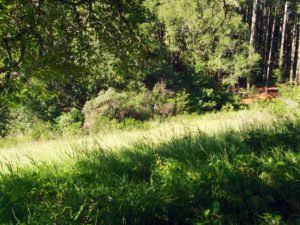
Other choices are semi-outfitted hunts, where the program offers private land, lodging, cooking facilities and direction to use the best methods, but you’re on your own from here on out. So first and foremost, bring a sharp knife.
A fourth possible choice might be the access-fee hunt, where you’re entirely on your own from setting up camp, scouting in your own vehicle and going at it blind unless you’ve been there before. Even though it appears we have ample opportunity to deer hunt, with the first season, archery, opening about the first weekend in July up to the final opening, about the first few days of October, opportunities are still extremely limited. You must decide and apply. The California Department of Fish and Wildlife website is much easier to decipher than it used to be and well worth checking out for particulars.
FAMILIARITY RULES
Knowing the lay of the land is necessary, and venturing out of state to hunt an access ranch is a daunting task. The same applies to California. There are many prebook questions that must be answered to your satisfaction. Four of us took this chance in 2010, venturing to Wyoming with deer and antelope tags in our luggage. We had to arrive prior to opening day, attend a seminar regarding the rules and regulations of the property, and tour the main sections of the ranch with the hunt coordinator and his son. Their prehunt requirements were well laid out and ranchers were available every day to rely on for advice.
Our hunt was five days in the field, and every tag we had was punched. We headquartered 11 miles from the ranch at a campground in Kaycee, Wyo., where there was a cooler available for our bagged carcasses. Everything we learned there was imperative information for here in California.
GOING PUBLIC
Back home brings us to the final option: hunting on public land. For most of us who started out on public land, this brings back positive memories of past successes and a few hairy situations. For me, it was introducing my then 10-year-old son to the new snows just at the edge of a pine forest while awaiting the migration – then getting our vehicle stuck. Of course this was before the days of the state’s zones.
Public hunts are available on CDFW land, state wildlife areas, ecological reserves, U.S. Forest Service and Bureau of Land Management ground. Research is necessary. There’s also the SHARE program, PLM tags, and special hunts for juniors.
The terrain might dictate any physical limitations as well as expected harvest figures, which are available from the CDFW website and broken down by zone. Travel distance is another consideration.
Before the zone days my son and I used to travel to the backcountry of Plumas County for weekend hunts, leaving after school on a Friday. A six-hour drive was rewarded with outstanding country and successful hunts. It’s still good, but you must draw for it.
Later on, at a friend’s suggestion we hunted public land in Mendocino County. We settled in on an area called Poison Rock, just north of a defunct Eel River ranger station. All of the ridges to the north of the dirt access road were closed to all vehicular traffic – thus the hunting was fairly good. It’s still a huntable area but much busier, especially with road hunters. There’s a bunch of land available if you’ll walk just a little.
When hunting close to private land, as in Trinity or Lassen Counties, a boundary line defined by a GPS is critical. Remember that trespassing without permission is against the law, and there’s a gray area between trespass and wanton waste. Public land abounds the further south you venture, but the success rates rapidly diminish and the hills get steeper. Right up the central California corridor, opportunities present themselves on both sides of I-5. We used to take off about a month prior to opening day and just drive, hitting huntable ground and making our own maps.
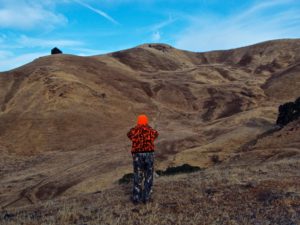
LIVE WELL IN CAMP
We’ve located our ideal campsite, so what’s next? As you age, it becomes apparent that comfort is just as important as any other feature of the trip. Sleep on the ground just once more in a tent? You can’t be serious. This desire prompted our first four-wheel-drive truck and a mini 18-foot travel trailer that seemed like a five-star hotel at the time.
We then added a 500-watt generator, an enclosed portable shower and a screen tent. Just as a mention, after arriving at your hunting location, this is not the time to sight-in five weapons and raise Cain in the campground. Public ground allows one to camp almost anywhere they wish, so don’t be surprised when you venture out opening morning – 4 miles from your chosen hunt area – to find six camps that were set up the previous night.
Try to stay hidden rather than stop right on the top of a ridge to glass for 30 minutes. Glassing for 30 minutes is the right approach, just not skylighted. If you carry a shooting stick, it can be used to steady your binos, as well as to shoot from.
When shooting on a stick, lean it towards you with the leg away from your body. This is far more stationary than leaning forward. Slowly check out the shady spots not only across the canyon but below you as well.
If you were able to reach these areas in the dark and used a green headlamp rather than a white light, sit for a spell and look. If cover is scarce, why not try a lightweight blind like the ones a turkey hunter uses?
Deer pick up movement far more quickly than they do a stationary hunter. The wind direction is critical, and when you have the option of watching a western slope in the morning, give it plenty of time. Spotting the glint of a buck’s antlers as soon as the sun hits them is far easier than picking them up in a darkened area.
If you are on a private-land hunt, consider a pop-up blind that’s properly placed and camouflaged. Chances are it will remain unmolested in your absence.
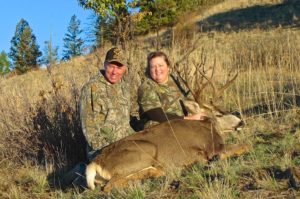
Since blacktail and granite bucks are not as predictable as whitetail, blind location should be in a general area where you feel confident that deer will be moving, such as at a pinch point. In our early zones and many later areas, it will be hot. If everything comes together, deer will move to water midmorning to midafternoon, as well as unbed to feed. Setting up in a forested area with the sun at your back where possible limits your shooting lanes, but that’s where the deer will be.
If approaching an open meadow, rather than just trek right through the middle, why not circle the edges inside the trees and stop to glass every 20 to 30 yards? The pattern here is obvious.
Going slow and having good optics are key, but patience is the largest key. When your camp holds three or four hunters, midmorning pushes will produce in blacktail country.
The shooters should be out of sight and the pushers with the sun at their backs should be slow and quiet. The
deer will know you’re coming well in advance of your movements and might not be running full tilt as they fly by your posted sitters.
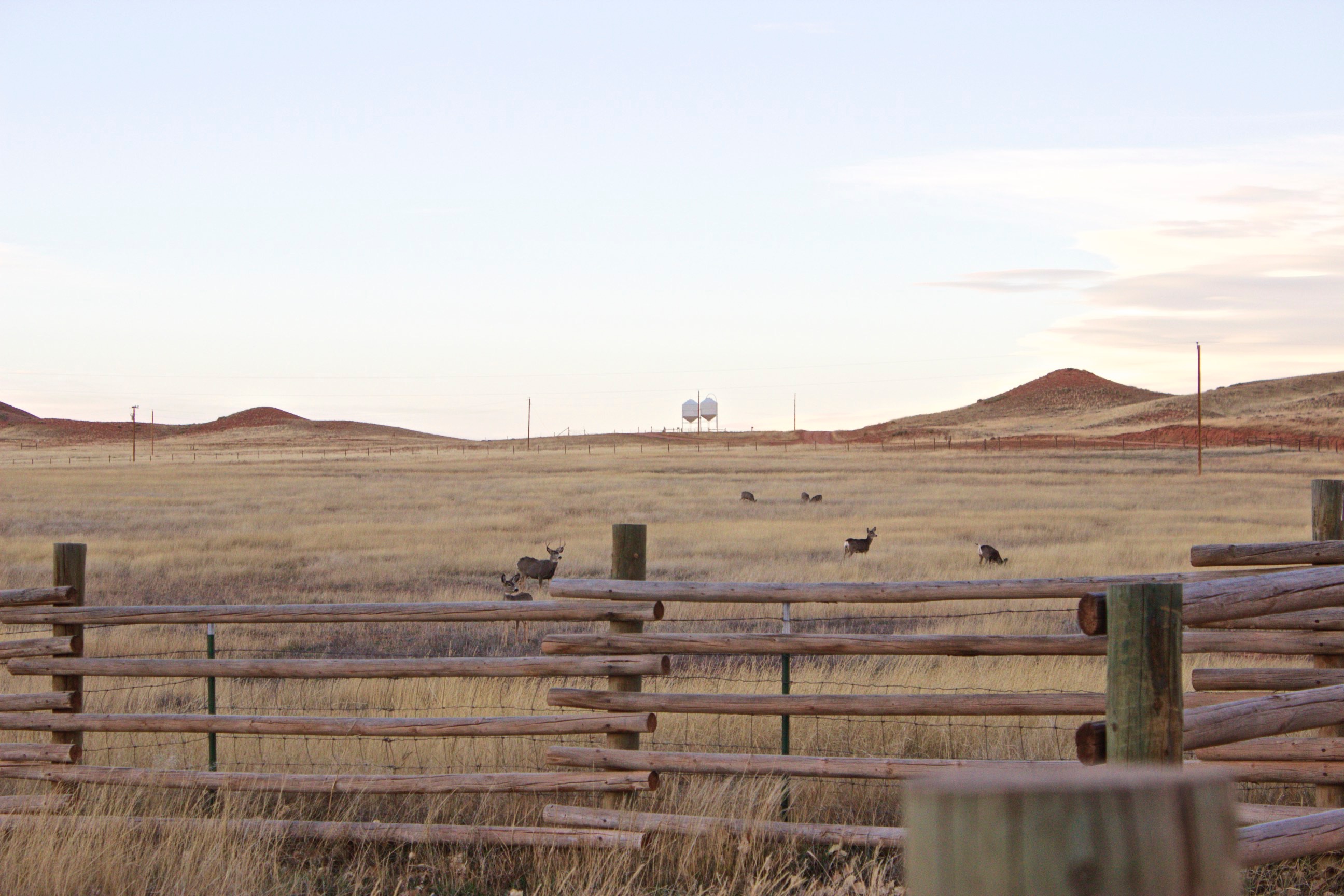
One last bit of advice: When you hear one of your hunters say, “deer down,” the entire hunt should terminate and full focus be placed on taking care of the animal.
Good luck this season. CS
Editor’s note: For season-opening dates, check out our Outdoor Calendar on page 33 and get more complete deer zone schedules at wildlife.ca.gov/Hunting/Deer.


